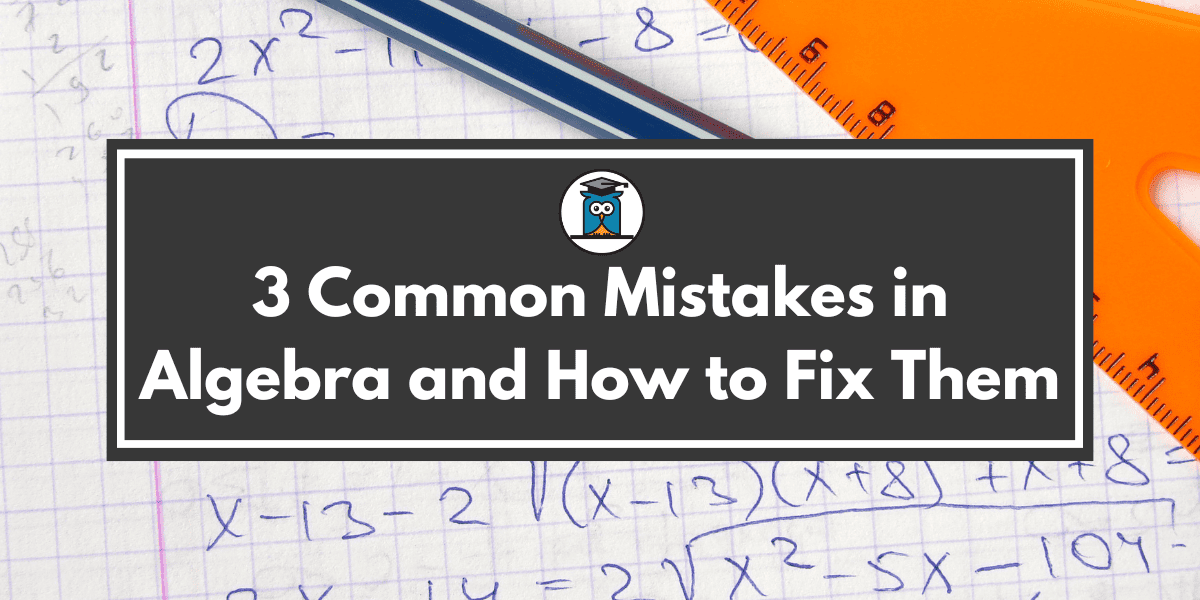By Alexander Lim, MPP Tutor
According to the online Oxford Languages Dictionary, algebra is “the part of mathematics in which letters and other general symbols are used to represent numbers and quantities in formulae & equations.”
In simpler terms, algebra deals with math equations involving variables, which are symbols that represent unknown values. Topics in algebra include what variables are, how to solve for variables, variables functions, operating on variables, and understanding statements with variables.
We use algebraic variable equations in almost every field of math. As such, becoming proficient in such a widely-used process is critical for students.
When first learning algebra, it’s common for students to make mistakes during particular step-by-step processes. Usually, the more steps involved, the easier it is to make a mistake. Moreover, it’s also common for students to fear of making mistakes, which can lead to test anxiety.
Thus, I will be going over the most common algebraic errors I come across as an experienced math tutor, and how you can avoid making these mistakes. As a result, it’ll be easier for you to motivate yourself to stop procrastinating and complete your assignments.
Mistake #1: arithmetic errors
Arithmetic errors are more common than you’d think.  These are mistakes you make during addition, subtraction, multiplication, and division with natural numbers. For example, I’ve seen people calculate 16/2 = 6, or 23 – 17 = 16 during intermediate steps. Messing up a single intermediate step will cause errors in every subsequent step. And the mistake “carries through”—so correct arithmetic is paramount.
These are mistakes you make during addition, subtraction, multiplication, and division with natural numbers. For example, I’ve seen people calculate 16/2 = 6, or 23 – 17 = 16 during intermediate steps. Messing up a single intermediate step will cause errors in every subsequent step. And the mistake “carries through”—so correct arithmetic is paramount.
Algebra can require long chains of these arithmetic operations, and I see many students skipping showing their work, calculating too quickly, and even incorrectly writing down the initial problem.
One tips is to take your time to neatly lay out your work, lining up the steps one above the other. This way, you can see the whole process if you need to review.
The best advice I can offer is to check your work by plugging your answer into the initial equation’s variable.
For example, if you need to solve 1 + 2x = 19 and end up with x = 7, you can easily tell you’ve made an error by substituting 7 for x in the initial equation:
1 + 2(7) = 19
1 + 14 = 19
15 = 19
This is a blatantly false answer, so you can now go back up to your chain of work to find the error. Start from the top and go down since the first error is the one you need to catch. (You cannot resolve any other errors until you identify that first one.)
In general: double check your work by substituting variables, and practice doing basic arithmetic to accurately work through these chains of equations. (The plugging in your answer method even works for multiple variables—watch an example here.)
Mistake #2: missing a minus sign
This is a mistake that even I still make occasionally!
Often, I see lots of students getting answers that are the opposite of the correct one (in terms of signage); x = -7 instead of x = 7, for example. Accidentally missing a minus sign early on in the algebraic solving process can result in subsequent arithmetic errors—for instance, subtracting instead of adding.
To counteract this, be very careful with your notations when dealing with negative numbers. 
Importantly, you need to remember the order of operations. The most commonly used acronym for remembering this order is PEMDAS: Parentheses, Exponents, Multiplication, Division, Addition, and Subtraction (in this order!). If you need to review your order of operations, you can find a video explaining it in detail here.
In terms of this order, do not think of negative numbers as subtraction; instead, think of them as multiplication.
-x is just a shorthand for -1 times x. So when you see -x2, apply the exponent first, NOT the negative. If you mean to express the square of the entire expression, use parentheses to emphasize that the negative is applied first: (-x)2.
And always remember: when multiplying (or dividing) something by a negative number, flip the sign of the result once. This is an easy way of remembering that a positive times a negative is a negative, and that a negative times a negative is a positive.
Finally, one last thing! Occasionally, you’ll have inequalities in algebra (i.e. x is greater than ( >) y. When multiplying or dividing both sides of an inequality by a negative, you must flip not signs of the expressions and of the inequality itself. Intuitively, think of negative multiplication like a mirror—you’re turning numbers into their opposites, so their inequality should be mirrored, too.
In general: make sure you understand the order of operations. Simplify expressions by reading them carefully and examining where the negative signs are.
Mistake #3: not applying operations to both sides of algebraic equations
This mistake usually means that you have a bit of trouble grasping algebra, conceptually.
When solving an equation for a variable, you usually must isolate the variable by applying operations to both sides of the equation, manipulating it by using the “properties of equality”. Sometimes, students apply their operation to only one side of the equation, making it unequal.
As I mentioned previously, checking your work by plugging in your answer is the best way to ensure that you made no mistakes. But learning is about improving—and to improve, it helps to have a more natural understanding of how equations work.
I find that reading equations out loud can help with developing a basic understanding of any given equation. For instance, “=” reads as “equals”, but you may understand it better if you think of it as “is”. The equal sign demonstrates that two sides of an equation are the same—2 + 2 = 4 means, “Two plus two IS four.” That is, 2 + 2 has all the properties and the same meaning as four.
In algebra, you want to make sure that the two sides of the equation are ALWAYS the same—so if you’re confused about why the properties of equality work, keep things simple for yourself. Remember that equations are about balance above all else.
That means, when you have an equation, you can add something to both sides, and it is still true. The same is true with any other math operation. So write out the operation you are doing to both sides, THEN simplify- show that you are keeping the equation in balance in an obviously true way. Don’t do it in your head.
Example algebra problem: breaking it down with words
Take the following equation:
-3x2 + 4 = -23
Say we want to solve for x. How would we go about it?
This statement is saying that -3x2 + 4 is the same as -23. But we want to isolate x in order to determine its value. And we do that by undoing the operations that are applied to x, in reverse. So first, undo the + 4 by subtracting 4 from both sides.
If -3x2 + 4 is the same as -23, then surely -3x2 + 4 – 4 is the same as -23 – 4.
After simplifying, we can say that -3x2 is -27. (Remember: subtracting a negative from a negative makes the number more negative, so -23 – 4 is -27 and NOT -19.)
Next, we undo the multiplication. Undo multiplying by -3 by dividing both sides by -3. So, continuing to modify the last statement (-3x2 = -27), we wind up with a statement that says:
-3x2 / -3 is -27 / -3
After simplifying, we get a statement (x2 = 9) that says x2 is 9. (Remember: dividing by a negative flips the sign of the first number!)
Finally, it’s time to undo the exponent. This is a tricky subject—square roots always have two possible solutions, a negative and a positive. So any time you take a square root, split the equation into two equations.
Taking the root of both sides, we get √x2 is √9. From that, we get two equations: the positive case, where x is 3, and the negative, where x is -3.
If you plug in both 3 and -3 in for x in the initial equation to check your answer, you’ll see that both of these are the correct answer, yielding -23 is -23, an obviously true statement.
Now, it is a REALLY long process to explain all of that with words, which is why we use numbers and symbols. Remember, math is a language of sorts, and there are rules for how it should look and how it should be read- just make sure you can consistently and easily understand what you mean when you write down an equation.
Example algebra problem: breaking it down with numbers
-3x2 + 4 = -23 (Problem)
- -3x2 + 4 – 4 = -23 – 4
- 2. -3x2 = -27
- -3x2 / -3 = -27 / -3
- x2 = 9
- √x2 = √9
- x = 3, x = -3 (Answer)
Check (x = 3):
-3(3)2 + 4 = -23
-3(9) + 4 = -23
-27 + 4 = -23
-23 = -23 (Checked)
Check (x = -3):
- -3(-3)2 + 4 = -23
- -3(9) + 4 = -23
- -27 + 4 = -23
-23 = -23 (Checked)
To solve this, I used essentially the same method as above, but I used symbols instead of words- “undo” the operations surrounding x, balance the equation by doing the same operations to the other side, simplify, and check via substitution. You can find another example using a different method here.
Final thoughts
Algebra is about balancing equations and shuffling numbers—and algebra mistakes usually mean that either something in the equation is unbalanced, or that you incorrectly moved a number somewhere. 
Algebra can seem very technical at times, but remember, math doesn’t have to be hard! Try to change how you think about what math is. Everyone has a different understanding of the same ideas, ESPECIALLY for something as obscure as math.
In my mind, for example, equations are like balance beams. On a balance beam, most people have a sense of the weight shifting, and can tell when the beam is unbalanced. This can apply to math, too. A lot of the time, as humans, we instinctively sense imbalances or errors in our work, just by using common sense.
If an equation looks wrong or you feel like you’re forgetting something, trust your gut and check your work, as you may have made an error somewhere.
My final word of advice to struggling algebra students: be critically confident of yourself.
Self-criticism and confidence may seem to be opposing ideas, but really, you should use self-criticism to assure yourself that you are learning and growing. Math is difficult to understand, which is why it is amazing that you CAN understand it.
Play around with concepts, ask yourself questions about how numbers work, and If you need help, go get it! Knowing your limits and finding ways to extend them is a quality that any student can learn and be proud of. You can do it!
And when you finally DO find the value of x, successfully graph a tough equation, or solve a complicated inequality problem, be proud! You can do algebra, and that’s awesome.







